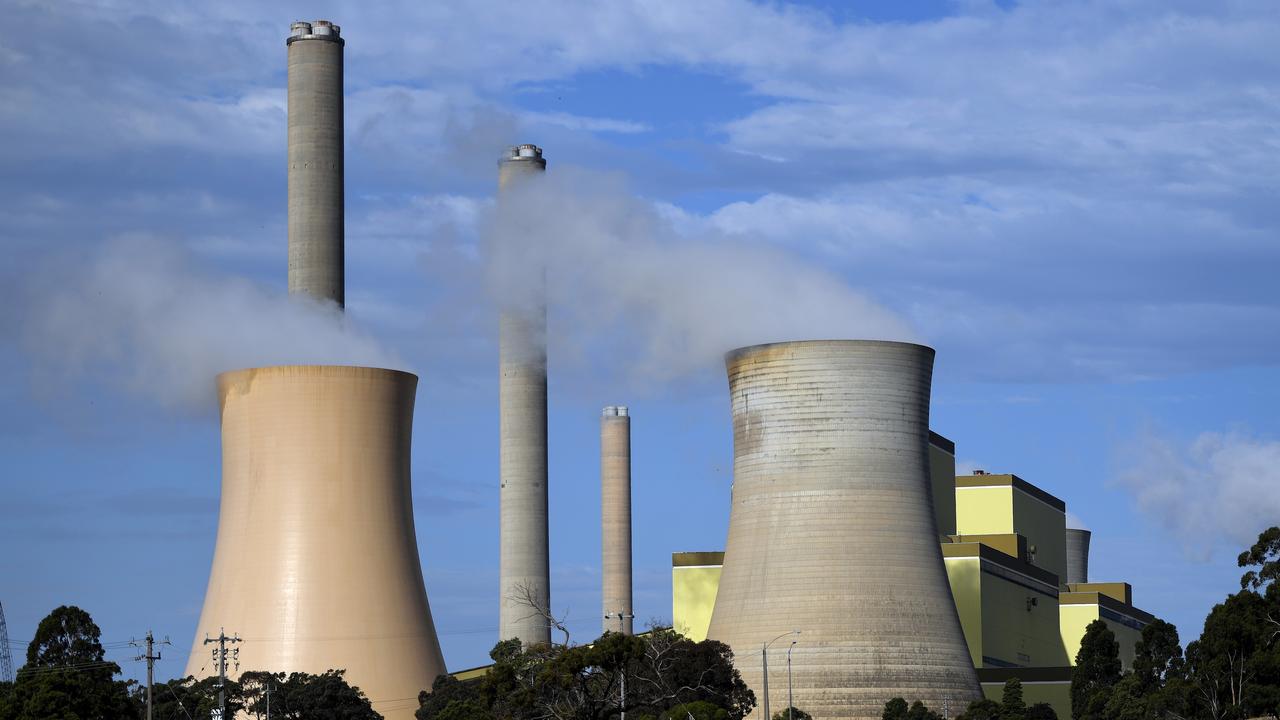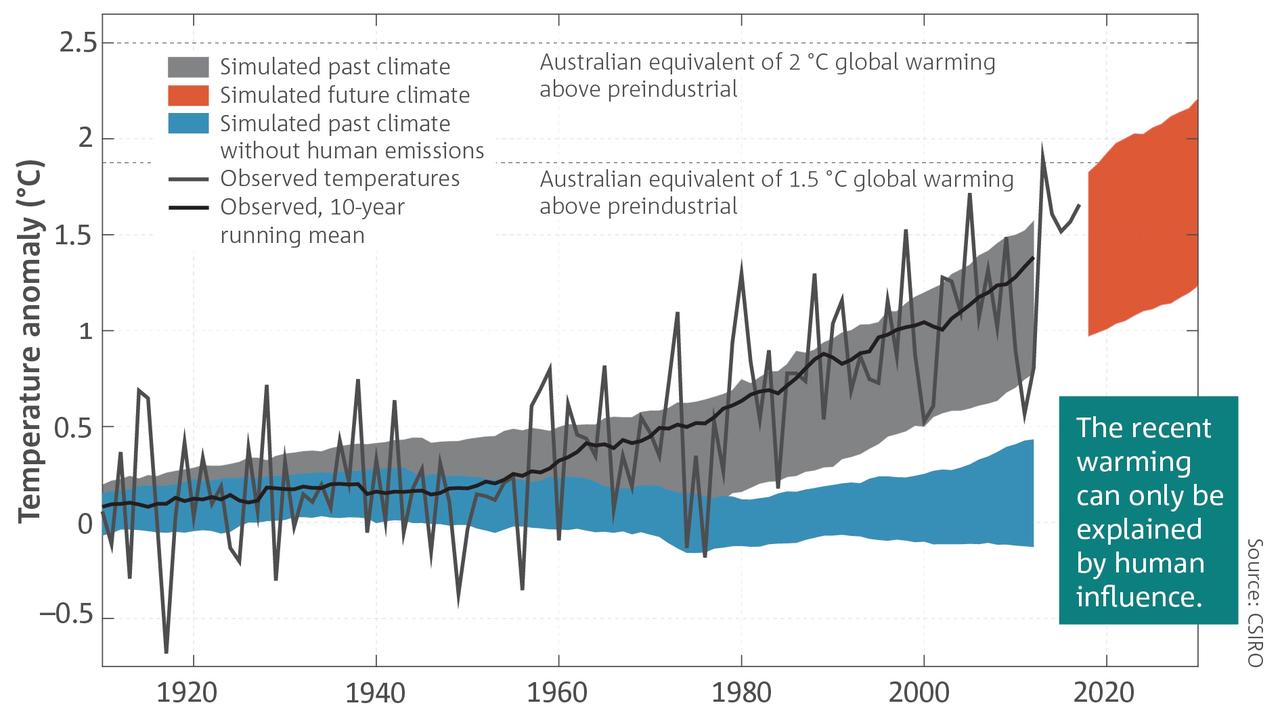The science behind climate change and its impact on bushfires
Australia’s catastrophic bushfire season has sparked intense debate over whether it’s linked to climate change. Here is the science.
When considering the science around climate change, one expert believes it’s useful to compare it to another famous hypothesis – the theory of gravity.
Not many people would think to cast doubt on the theory of gravity, and according to Professor David Karoly, who leads the Earth Systems and Climate Change Hub in the Australian Government’s National Environmental Science Program at CSIRO, the evidence that human activity is causing global warming is so strong it is equal to this theory.
“The theory on the human impact on climate change is just as strong, or stronger, than the scientific basis for the theory of gravity,” Prof Karoly told news.com.au.
Prof Karoly said that there was also evidence climate change was a factor in recent devastating bushfires in Australia.
RELATED: Photos that sum up Australia’s unprecedented fire season
RELATED: How 2019 bushfires compare to other years
Prof Karoly will explain the science at a free public lecture as part of the Australian Mathematical Sciences Institute 2020 Summer School public lecture in Melbourne on Wednesday, January 29. His speech will also be streamed online.
When we talk about science, Prof Karoly believes it’s helpful to remember we are not talking about “beliefs”.
Science is in fact a process that tests a hypothesis to provide conclusions about the way nature works.
Not convinced? Here’s the science.
HOW DO WE KNOW HUMANS ARE CAUSING IT?
Some say the world’s climate has always changed and in the past there have been ice ages and warmer glacial periods, which is true.
The difference is whether humans have caused the changes.
We know that humans could not have had any influence on the past ice ages for example, because there were no humans on the planet.
So how do we know that the climate changes now are due to human activity?
Prof Karoly said there were two approaches.

LET’S LOOK AT WHAT WE CAN OBSERVE
The first approach involves examining “observational data”. If we want to identify long-term trends we need to look at data collected over a wide area and across at least 30 years.
To figure out why the Earth is warning, there are some logical factors to look at first.
The main things that impact the Earth’s climate are sunlight from the sun, how it is absorbed in the atmosphere and how energy is lost from Earth and sent into space.
One thing that can impact the amount of sunlight we get includes the amount of clouds, ice and snow because they all reflect sunlight, making it cooler.
However, greenhouse gases in the Earth’s atmosphere can also affect temperatures. These gases make the planet hotter because they absorb heat radiation from the Earth and prevent this from being released into space as quickly.
Greenhouse gases can include carbon dioxide, methane and water vapour.
“When greenhouse gases increase, the surface temperature of the Earth increases,” Prof Karoly said.
So what does the data tell us about these factors?
‘SOMETHING WEIRD IS HAPPENING’
Analysis of air bubbles from ice cores trapped in ice in Greenland and Antarctica showed that over the last 10,000 years, carbon dioxide varied a small amount, hovering around 280 and 290 parts per million.
But if you look at the last 150 years, it’s a different story. Carbon dioxide now sits at 400 parts per million.
“This has increased by more than 40 per cent,” Prof Karoly said.
“It is higher than at any time in the last 10,000 years. In fact, it’s higher than any time in the last million years.”
“So that suggests … something weird is happening.”
Prof Karoly said you had to go back more than three million years to find a time when carbon dioxide was around 400 parts per million.
“Three million years ago when carbon dioxide was higher, temperatures were more than two degrees warmer and sea levels were more than 10 metres higher,” he said.
Humans were not around three million years ago so they can’t be blamed for the high amount of carbon in the atmosphere.
So what was cause of these higher levels of carbon dioxide?

Some experts have suggested the carbon dioxide was actually being released from the ocean.
“A warmer ocean can’t absorb as much carbon dioxide,” Prof Karoly said. “As it heats up, it can’t hold as much carbon and this is released into the atmosphere.”
However, the type of carbon dioxide the ocean releases is different to that released by burning fossil fuels and land clearing.
Prof Karoly said the carbon dioxide has a different chemical composition so scientists are able to distinguish between the two.
“Carbon dioxide released from the ocean doesn’t use up oxygen,” Prof Karoly said.
Over the last 40 years, scientists have been able to monitor the amount of oxygen in the atmosphere and the fall in oxygen has exactly matched the increase in carbon dioxide that you would expect if it was coming from the burning of fossil fuels and decomposition of vegetation from land clearing.
“What we now know, is that the increase to carbon is not natural, it’s due to human activity, from the burning of fossil fuels and land clearing,” Prof Karoly said.
This is not just a theory, it is based on “observational evidence”, that is, scientists have data that shows the increased carbon dioxide in the atmosphere is coming from fossil fuels and land clearing.
AND NIGHTS ARE GETTING HOTTER
We can also look at other observational data to help strengthen the theory.
If the Earth was warming up because of increasing sunlight, then you would expect temperatures during the day to increase and for it to be cooler at night (because there is no sun at night!).
However, what scientists found is that nights were actually warming up more so than days.
This points to greenhouse gases playing a role.
As noted above, greenhouse gases trap heat radiation from the Earth and stop it from being released into space as quickly.
This effect can be seen for example, on nights with more clouds, which don’t cool down as much as there is more water vapour in the atmosphere.
In contrast, deserts are more cool at night because there is not as much water vapour over these areas, and it’s a similar story in coastal areas.
So if nights are warming up more than days, it’s unlikely that the sun is playing a role in this, it’s more likely that greenhouse gases are trapping heat on Earth and pushing up temperatures.

Scientists have also looked at temperatures in the Earth’s stratosphere, which is the layer of the atmosphere from about 10km up.
The stratosphere warms because the ozone layer it contains absorbs the sun’s ultraviolent radiation.
If there was more sunlight, you would expect the upper atmosphere to warm up because it was absorbing more ultraviolet rays.
But if there was an increase in greenhouse gases then you would expect the stratosphere to be cooler because carbon dioxide is efficient, not only at absorbing heat radiation but also at releasing it into space, cooling it down.
“Observations have shown that the surface and lower atmosphere have warmed, and the upper atmosphere has cooled in the last 50 years — the entire time we’ve been monitoring it through balloons and other satellites,” Prof Karoly said.
“This pattern of temperature change has happened everywhere and cannot be explained by increasing sunlight,” he said. “And it’s been getting stronger, which is exactly what you would expect from increasing greenhouse gases in the atmosphere.”
NOW ADD COMPUTERS TO THE EQUATION
The first approach to looking at climate change is “observational data” but you can also use complex mathematical models of the climate system.
Around the world, Prof Karoly said more than 50 complex climate models had been developed to test climate theories on a larger scale.
While some may question how scientists could simulate the climate when they can’t forecast the weather over long periods of time, Prof Karoly said it was because the climate models looked at levels of radiation, which determine long-term climate.
“Models solve physical equations for the absorption and transmission of radiation in the atmosphere, and for the motion of the air, and for the motions of the ocean,” he said.
These simulations have shown that without human influences there would not be any long-term warming trend.
Temperatures would have stayed pretty much the same with only two-tenths of a degree of warming.
Instead the world has warmed by 1.1 degrees and the warming over Australia has been even higher than the global average, at 1.5 degrees.
This is because land warms up faster than the ocean.

WHAT ABOUT THE BUSHFIRES?
So how does this relate to the catastrophic bushfires that have raged across Australia in recent months?
Higher mean temperatures give rise to a greater chance of heatwaves and hot extremes, Prof Karoly said.
“We have good observational data of the current summer and the last 50 years,” he said.
“There have been marked increases in heatwaves and hot days in all parts of Australia.”
Australia experienced its hottest and driest year on record in 2019 and December 2019 had a number of Australia’s hottest days ever recorded.
“We have also seen increases in sea levels, exactly what you would expect from climate change and the warming of ocean waters and melting of ice sheets and glaciers on land.”
When it comes to the intensity of bushfires, Prof Karoly said there are certain factors that were known to be important.
The McArthur Forest Fire Danger Index was developed to measure the degree of fire danger in Australian forests and the likelihood they will occur.
It combines factors including the temperature of air, wind speed, the dryness of the air (measured by relative humidity) and the dryness of the fuel and the ground (measured by rainfall over the previous month).
“So the combination of high temperatures, strong winds, low humidity and no rainfall leads to extreme fire danger,” Prof Karoly said.
These were exactly the conditions experienced in NSW and southern Queensland in September and October where there were record high temperatures and low humidity.
These conditions were also experienced in Canberra, coastal NSW and particularly East Gippsland in Victoria, which was why there was extreme fire danger in these areas.
The next question is whether climate change caused these conditions.
Prof Karoly says climate change has led to higher temperatures, as discussed above, but it’s unlikely it had a major role in the drought conditions.
He said if the rainfall in 2019 was related to climate change you would expect wetter conditions in northern Australia, not the record dry year experienced in 2019.
Climate change has also been linked with the long-term rainfall in the cool season in south-east Australia.
Prof Karoly believes the drought in 2019 may actually be due to “natural variations” and the “Indian Ocean Dipole”.
The IOD refers to the seesawing temperatures in the Indian Ocean, with colder waters closer to northern Australia and hotter waters closer to Africa.
There were also changes in wind patterns in the south of Australia and over Victoria and NSW, which led to stronger westerly winds that reduced the rainfall over the NSW coast and East Gippsland, where the worst fires and conditions have been.
Prof Karoly believes it was the stronger westerly winds and the Indian Ocean Dipole that ramped up the fire intensity, however, this was combined with the extreme temperatures caused by climate change, sparking Australia’s deadly fire season.
“So it was a combination of natural climate variability and climate change,” he said.
Continue the conversation @charischang2 | charis.chang@news.com.au




